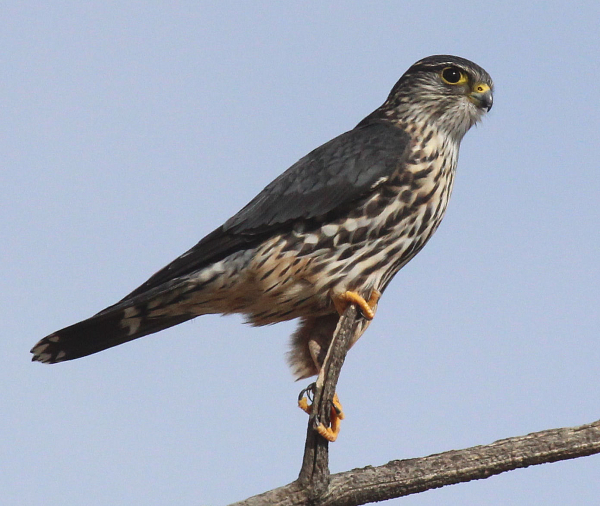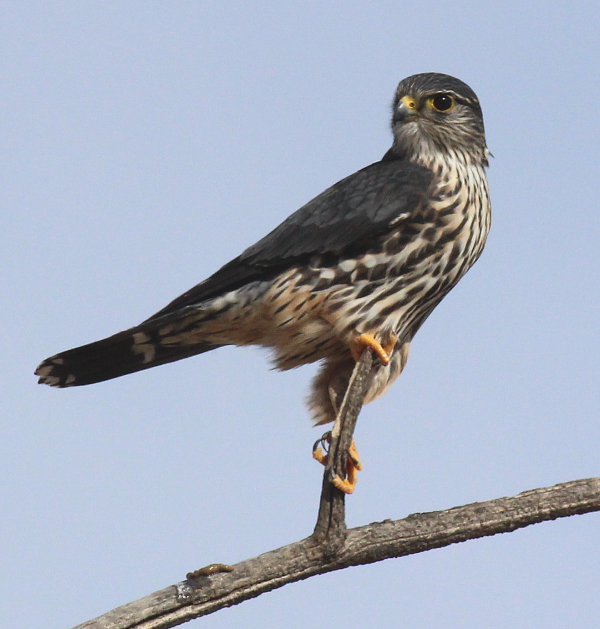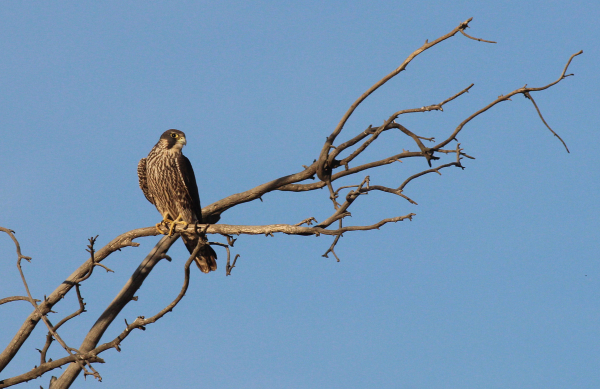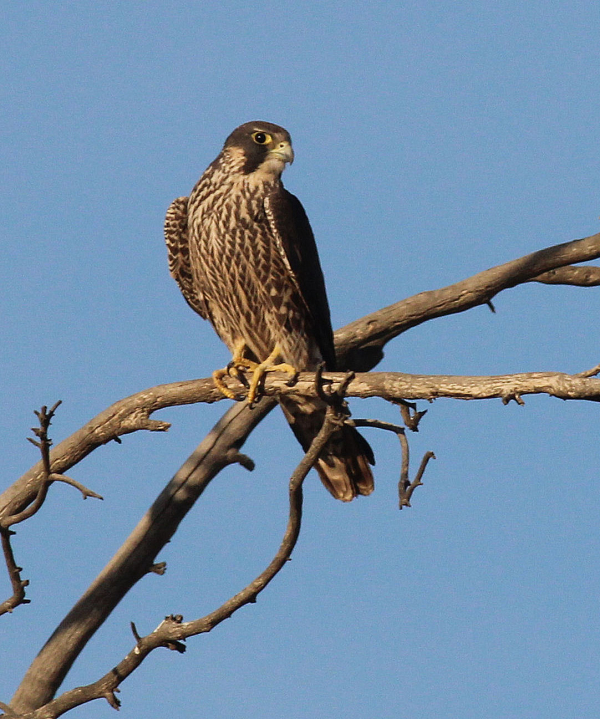When you need a little Magic in your day, who ya gonna call? Merlin of course! And when you’re really lucky, Merlin arrives. But not Merlin the Magician, Merlin the dynamic species of falcon with a big attitude in a small package. One memorable winter day, my Merlin magic was unparalleled: Within 200 yards I encountered three Merlins! This, an hour after I said to Talia, a co-worker on a southern California nesting bird study, “You never know what might show up at any given moment.”

Paul may never be able to improve on this portrait of a dynamic male Merlin that perched in the open at close range with perfect afternoon lighting.
First, I found a female Merlin perched with a recently captured wintering Yellow-rumped Warbler in her talons, but although she was a beautifully colored falcon she was perched among many thin branches that did not provide a clear view of her. A little farther down the road, as I turned around at the same location where I encountered and photographed a Peregrine Falcon two weeks before, a small falcon flew in from the southwest, and darned if it didn’t land on a bare tree about 100 feet away. It was a male Merlin that almost resembled a miniature Peregrine as it settled onto its perch.
I decided to try to get closer to the male with the hope of finding a position where branches didn’t obstruct the mini-falcon. But suddenly another male Merlin flushed from the cover of eucalyptus leaves to perch on a bare branch right beside me with the clear sky behind it and beautiful late-winter sunlight illuminating the mini-falcon for my camera. As I photographed the magic raptor I noticed its very dark coloration, indicating it originated from the northern forests of western Canada or Alaska – a true Taiga Merlin.

As if seeing three Merlins within 200 yard wasn’t exciting enough, the third Merlin provided a memorable photo opportunity – what luck!
Wow, three Merlins in just a few minutes – and the grand little falcon before me was especially photographic, providing my best portraits of the species to this day. This isolated grove of trees along a watercourse in open ranch country was a definite falcon hangout, and I encountered several Merlins there during regular visits, along with a couple Peregrines. Plus, one of the reasons I was drawn back to the location time and time again was that there were a few pairs of nesting Burrowing Owls that I was monitoring scattered across a 20 acre area. How much fun can you have at one location?
The photographic moral of the story is that not every bird you encounter will provide an opportunity to photograph it. Some birds provide a chance for a documentary photo, but not necessarily a pleasing image. Some birds seem to taunt you by showing themselves, but keeping a few branches or leaf clusters between you and them. And when you least expect it, one pops into position as though you conjured it to perch there to utilize the prime sunlight, blue sky background, and close proximity to make a mental impact.

This Peregrine image was cropped to use the flow of the weathered branches to highlight the falcon’s setting.
The rest is up to your camera: The light meter does its job, the autofocus does its job, the shutter speed and aperture settings combine to provide the best image you can hope for. Clearly, these are the kinds of opportunities we must be ready for in advance of when they happen. Have your camera in hand, or within reach – not in a case or backpack in the back seat. Pre-set the aperture preference (Av) setting for the current light conditions, say an f8; or if you anticipate a background, perhaps an f6 to try to throw the background out of focus. Using the Av setting on your camera, the shutter speed will be set automatically, depending on the aperture setting you use and the available light conditions; but using an f6 or f8 should provide a fast shutter speed.
Of course, try to steady your camera lens against something, or tuck your elbows into your chest to form a solid base with your arms. And even though you may be breathing heavily with excitement, hold your breath as you take photos. Try to keep your wits about you as your heart beats wildly, your muscles tense up, and your mind races. But be sure to enjoy the moment too. Marvel at the feathered dynamo before you; appreciate the chance to be so close and for all the magic to come together as a wonderful surprise of nature and timing.

The same image was cropped again to produce a pleasing portrait of the young male Peregrine Falcon.
The opportunity to observe Merlins and get a sense of what they are all about was fun – they are intense little falcons that turn on like a light switch and transform from cute little birds into intense killas using dynamic acrobatic flights. Magic indeed, each Merlin charged me with a considerable shot of adrenaline – enough to make me thankful for such wonderful birding ops, yet wishing for more.
And wishes do come true: Not long after the above Merlin encounters, while checking back on the progress of the nesting Burrowing Owls I spied a beautiful young Peregrine Falcon perched on a bare branch adjacent to where I photographed the Taiga Merlin. I wasn’t as close to the little male Peregrine, so after taking my photos of this exceptional avian dynamo, I cropped a favorite image to use the flow of the weathered branches to highlight the Peregrine’s position from a distance; then I cropped the image again to create more of a portrait of the memorable encounter. Again, the falcon makes the resulting images very special, and it provided both a memorable field experience and some favorite photographs.
Best Wishes to you for bigger and better photo opportunities and ever-improving images during 2020!
Article and photos by Paul Konrad
Share your bird photographs and birding experiences at editorstbw2@gmail.com